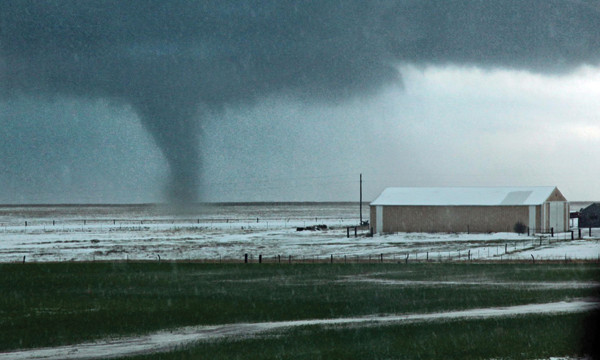
by Mary Caperton Morton Tuesday, December 9, 2014

Tornado season is peaking earlier in the spring than it did 60 years ago. Credit: ©Lauren Ayres, CC BY-NC 2.0.
Recent studies have examined whether tornadoes are increasing in intensity or number, but a consensus has not yet been reached. Now, a new study looking at a different aspect of tornadoes — when they occur — has found that the severe storm systems that spawn tornadoes may be peaking earlier in the spring than in the past in the infamous tornado alley.
“People are very concerned, for good reason, about the number of tornadoes per year, but nobody had really looked at whether the window for tornado season is changing over time,” says Paul Stoy, an environmental scientist at Montana State University (MSU) and co-author of the new study, published in Geophysical Research Letters.
By combing through a 60-year database maintained by the National Weather Service, Stoy and his colleague John Long, also at MSU, found that peak tornado activity in tornado alley — a swath of the central and southern Great Plains that includes Nebraska, Kansas, Oklahoma and northern Texas — is occurring up to two weeks earlier than it did half a century ago, potentially lengthening the season. “Two weeks may not seem like much, but remember there’s only 52 weeks in a year,” Stoy says. In the heart of tornado alley, the peak has moved up from the end of May toward the middle of the month.
Long decided to investigate the trend on a hunch that tornadoes seemed to be occurring earlier in the spring. “Those of us who track tornadoes had a feeling this earlier season trend might be going on, but it’s difficult to see through the noise,” says Greg Carbin, a meteorologist at NOAA’s Storm Prediction Center in Norman, Okla., who was not involved in the new study.
In a previous study, Carbin found that the meteorological conditions necessary for producing severe storms — including warm moist air, lift and wind shear — also seem to be occurring in the Midwest earlier in the year. “My study corroborates their findings, using an entirely separate dataset, so we may be on to something,” he says.
Part of the problem with studying tornado trends is that there are no proxies in the geologic record for tornadoes; eyewitnesses are needed. “We can’t look at ice-core or tree-ring data to determine the number of tornadoes in the past so we’re relying on 60 years of eyewitness reports and the database is warped due to increased reporting of smaller tornadoes in recent years,” Carbin says. But despite the pitfalls of dealing with the potentially biased database, “[Stoy and Long] seem to have done their homework and theirs seems to be a significant finding.”
The factors that may be contributing to the earlier onset of tornado season are complicated, Stoy says, and outside the scope of this study. “There’s not going to be a single explanation — like warming — for this shift,” he says. “We’re dealing with interactions between larger-scale climate features like El Niño and local and regional patterns. It gets complicated very quickly, but we’re working on sorting it all out.”
In the meantime, the findings may be helpful in increasing public awareness about the year-round dangers of tornadoes, Stoy says. “We need to get people in the mindset that tornado season is 365 days long; tornadoes can happen any day of the year.”
© 2008-2021. All rights reserved. Any copying, redistribution or retransmission of any of the contents of this service without the expressed written permission of the American Geosciences Institute is expressly prohibited. Click here for all copyright requests.